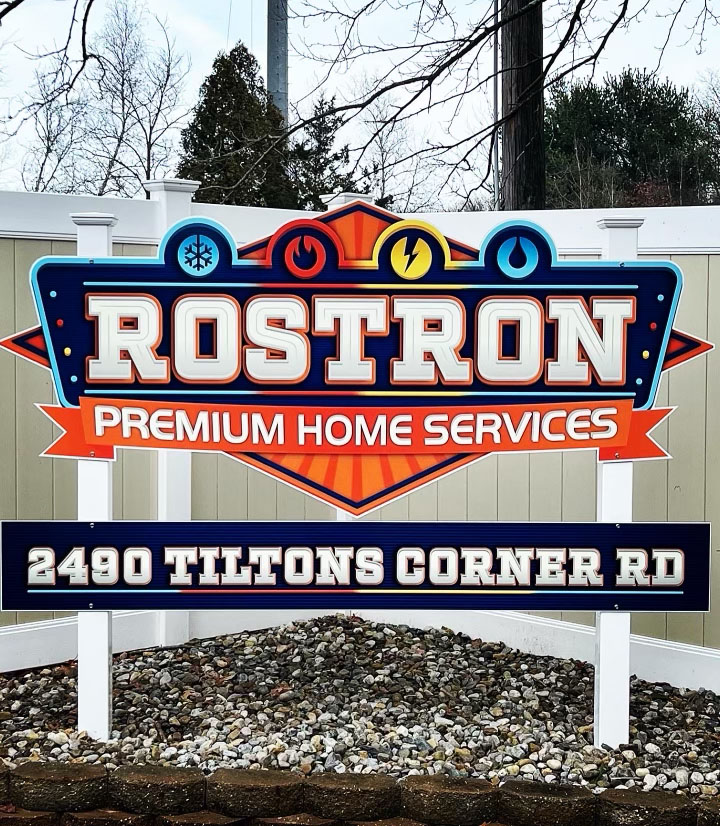Rostron Premium Home Service customers are installing smart thermostats every day! If we install a new HVAC system in your home, you’re most likely getting a smart thermostat. Smart thermostats are increasingly becoming a focal point for those looking to enhance their home’s energy efficiency and comfort. With the ability to learn from your habits and adjust your home’s temperature accordingly, smart thermostats promise not just increased comfort and convenience, but also significant energy savings.
Understanding Smart Thermostats
Smart thermostats are advanced devises that manage your home’s temperature with precision and flexibility. They connect to your home’s Wi-Fi network, allowing you to control your heating and cooling systems remotely via smartphones, tablets, or voice assistants. This connectivity is a significant leap from traditional thermostats, which require manual adjustments and lack the ability to learn from your habits.
The intelligence of smart thermostats lies in their use of sophisticated technology:
- Wi-Fi Connectivity: This feature is the backbone of a smart thermostat’s functionality, enabling remote access and control. It allows homeowners to adjust their home’s temperature from anywhere, at any time, via a mobile app or web interface.
- Sensors: Smart thermostats are equipped with a variety of sensors that monitor not just the temperature, but also humidity, occupancy, and even light levels in some cases. These sensors provide the data necessary for the thermostat to make informed decisions about heating and cooling, ensuring comfort while optimizing energy use.
- Learning Algorithms: Perhaps the most innovative aspect of smart thermostats is their ability to learn from your behaviors and preferences. By analyzing the data collected from their sensors over time, these devices can automatically adjust settings to suit your schedule and preferences, without you needing to program them explicitly. For example, they can lower the heat when the house is empty during the day and bring it back up before you return in the evening, ensuring comfort while minimizing energy waste.
- Integration with External Factors: Advanced models take into account not just the data from their sensors but also external information, such as local weather forecasts. This allows them to adjust the indoor climate more effectively, taking into account anticipated changes in outdoor temperatures, which further enhances energy efficiency.
ADVANTAGES OF SMART THERMOSTATS
ENERGY SAVINGS
One of the most compelling reasons to switch to a smart thermostat is the potential for energy savings. By learning your schedule and adjusting the temperature accordingly, smart thermostats ensure that you’re not heating or cooling your home when it’s not needed. The U.S Department of Energy highlights that homeowners can save an average of 10% on heating and up to 15% on cooling per year by using a smart thermostat.
REMOTE CONTROL AND ACCESSIBILITY
The convenience of controlling your home’s temperature remotely cannot be overstated. With a smart thermostat, you can adjust your home’s heating and cooling systems from anywhere, at any time, via a smartphone app. This means you can turn up the heat on your way home from work or cool down your house before you return from vacation, all from your mobile device.
INTEGRATION WITH SMART HOME SYSTEMS
Smart thermostats are designed to be integral components of the smart home ecosystem. They can seamlessly connect with other smart devices, such as lights, locks, and security systems, creating a cohesive and intelligent home environment. This integration enables scenarios where your thermostat can adjust the temperature based on inputs from other devices, like turning off the heat when the smart door lock indicates you’ve left the house.
Moreover, with voice assistant compatibility, controlling your home’s climate becomes as simple as speaking a command.
COST ANALYSIS OF SMART THERMOSTATS
INITIAL COSTS
The upfront cost of smart thermostats encompasses both the purchase price of the device and installation fees, which can vary widely based on the features, brand, and compatibility with your existing HVAC system. The purchase price for a smart thermostat can range significantly, it’s very important to have a technician who knows how to install them properly…
Installation costs can also vary, depending on whether you opt for professional installation or a DIY approach. While some homeowners may feel comfortable installing a smart thermostat themselves, professional installation is recommended to ensure optimal functionality, particularly for thermostats requiring complex wiring or integration with a broader smart home system.
LONG-TERM SAVINGS
Despite the initial investment, smart thermostats can lead to substantial long-term savings on your energy bills.
The break-even point—when the savings on your energy bills offset the initial costs of the smart thermostat—can vary. However, many Rostron Premium Home Service customers report recouping their investment within one to two years, after which they continue to enjoy reduced energy costs. Additionally, some utility companies offer rebates or incentives for installing energy-efficient devices, including smart thermostats, which can further reduce the initial cost and shorten the payback period.
INSTALLATION AND COMPATIBILITY OF SMART THERMOSTATS
INSTALLATION PROCESS
Installing a smart thermostat is a task that ranges from straightforward to complex, depending on the existing HVAC system in your home and the specific smart thermostat model you’ve chosen. The basic steps typically involve removing your old thermostat, installing the new smart thermostat base plate, connecting the wires, and then attaching the new thermostat to the base plate. Finally, you’ll need to configure the thermostat using its interface or a connected app.
While some homeowners with DIY experience and a simple HVAC system might find the installation process manageable, professional installation is recommended. This is because professional installers can ensure that the thermostat is correctly installed and fully compatible with your HVAC system. They can also handle any issues that might arise, such as the need for a common wire (C-wire) that provides continuous power to the thermostat. Not all homes have a C-wire already installed, and a professional can install one if needed, ensuring your smart thermostat functions optimally.
IMPORTANCE OF PROFESSIONAL INSTALLATION
Professional installation offers several benefits:
- Expertise: Certified technicians have the knowledge to install smart thermostats without risking damage to your HVAC system or the thermostat itself.
- Troubleshooting: Professionals can immediately address any compatibility issues or wiring problems, ensuring your system runs smoothly.
- Optimization: Installers can help set up and configure your smart thermostat to work efficiently with your HVAC system, taking into account the specifics of your home layout and your personal preferences.
COMPATIBILITY ISSUES
Before purchasing a smart thermostat, it’s crucial to verify that it’s compatible with your existing HVAC system. Most smart thermostat manufacturers provide online tools or compatibility checkers on their websites where you can input details about your current system to determine if the thermostat will work in your home.
Compatibility considerations include:
- System Type: Ensure the smart thermostat can handle the type of heating and cooling system you have, such as gas, electric, dual fuel, or heat pump systems.
- Voltage Requirements: Most smart thermostats are designed for low-voltage systems. If you have a high-voltage or line-voltage system (common in older homes or with some baseboard heating), you’ll need to find a model specifically designed for those systems.
- Number of Zones: If your home has multiple heating or cooling zones, you’ll need a thermostat that can manage this complexity.
ENSURING A RIGHT FIT
To ensure a smart thermostat is a right fit for your home, consider the following steps:
- Use Compatibility Checkers: Utilize tools provided by manufacturers to check system compatibility before purchase.
- Consult a Professional: Consider a consultation with an HVAC professional to get advice tailored to your specific system and needs.
- Read Reviews: Look for reviews or forums where people discuss using the thermostat with a system similar to yours.
POTENTIAL DRAWBACKS OF SMART THERMOSTATS
PRIVACY AND SECURITY
Another concern is privacy and security. Smart thermostats, like many connected devices, collect data on your home and your habits. This data can include when you are home or away, your preferred temperatures, and even your location if you use geofencing features. While this information is used to optimize your heating and cooling systems, there is always a risk that it could be accessed by unauthorized parties if not properly secured.
USER COMPLEXITY
Finally, the advanced features of smart thermostats that make them so appealing can also present challenges for some users. The array of options and settings, while customizable, can be overwhelming, especially for those who are not tech-savvy or prefer simpler devices. Learning to use all the features effectively to maximize energy savings and comfort can take time, and some users may not find the effort worthwhile.



